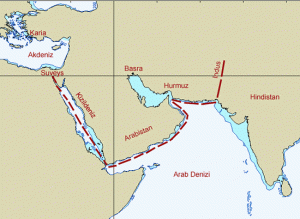Skylax: A “Rooster” from Gölköy Mercenary, Commander and Discoverer in the service of Emperor Dareios of Persia
“44: Of the greater part of Asia Dareios[1] was the discoverer. Wishing to know where the Indus, which is the only river save one that produces crocodiles, emptied itself into the sea, he sent a number of men, on whose truthfulness he could rely, and among them Scylax of Caryanda, to sail down the river. They started from the city of Kaspatyros [2] , in the region called Paktyia [3] , and sailed down the stream in an easterly direction to the sea. Here they turned westward, and, after a voyage of thirty months, reached the place [4] from which the Egyptian king, of whom I spoke above, sent the Phoenicians to sail round Libya [5]. After this voyage was completed, Dareios conquered the Indians, and made use of the sea in those parts. Thus all Asia, except the eastern portion, has been found to be similarly circumstanced with Libya.” [6]

With these words the Father of History, Herodot of Halicarnassos, introduces in his Histories his fellow Karian, Skylax of Karyanda, todays Gölköy.
The mentioned expedition of Skylax (or Skulax) reaches modern times through a copy of his Periplus (Greek for “Sea Voyage”). In the antiquity, Peripli were coastal pilot books, based on ships’ logs and guiding mariners through coastlines, continents, countries, islands describing winds, waves, shoals, wells and other relevant nautical information. The Periplus of Skylax of Karyanda [7] was written down about a century after the expedition.
According to the Periplus, Skylax follows the Asian coastline until Oman. Without entering the Persian Golf, he follows the Arabian Peninsula into the Red Sea up to the Sinai Peninsula. [8] [9]
Similar pilot books in medieval times were called Portoloni. As Peripli and Portoloni based on ships’ logs, thus on primary information, they represent valuable documents in the history of science.
In Antiquity as today, Karia was an infertile soil and the life standard was lower than in, say Pamphilia or Mesopotamia. Karian men (and occassonally women, see Queen Artemisia) dealt with this natural obstacle by specializing as professional soldiers and seamen. Skylax, too, was a professional, who had worked his way up within the Persian ranks. The Karians had some important discoveries in martial arts, too. Again Herodot reports, that the shield handle and the crested helmet were some of them [10] . It should be emphasized that an improvement from the shoulder strapped shield to the handled shield, as trivial this may sound today, changed the fate of ancient battles decisively.
Due to the crested helmet they had introduced to the Antiquity, the Karians were nicknamed by contemporates as “the roosters”.
Who were these “Roosters”?
The following has been summarized from Jona Lendering. [11]
The Kingdom of Karia was mentioned first during the Old Assyrian and the Hethite period (1800 – 1200 BC)
Karia was called by the Hethites Karkissa and by the Persians The Satrapy of Karkâ. After a rather long period of darkness, Karia is picked up again by Homeros. In his Catalogue of Ships Homeros mentiones that the Karians live at Miletos and the Mycale Peninsula[12] and discloses an important fact about them: The Karians fought the Tojan Wars on the side of the Anatolian Trojans [13] .
This is rather important as it supports, opposite to the common view, that Miletos was not a Greek town, that the Karians were no immigrants from the Ionian islands, and that the Karians were indigenious – as they strangely kept emphasizing at all occasions themselves. Modern linguistic research also shows that Karian is member of the Indo-European language family and related to Hethitian.
Herodot also mentiones that the inhabitants of Miletos speak Greek with a Karian accent [14] . Even Herodot personally displays his distinct Karian background: His father’s name, Lyxes, is based on the popular Karian name Lukhsu.
Often mentioned are the mountain bastions of the Karians, not much is said though about their urban settlements. Like in other similar geographic areas where mountains hamper contact between various valleys they developed numerous different scripts and tried to write with several variations of the Phoenician alphabet.
They were united, though, by religion. Mylasa was one of their most holy centres where a local god of war, the Karian Zeus in the grecified version, was worshipped.
Thus, war was worshipped by the Karians and this brings us back to the Karians as martial artists. As mentioned above, the natural conditions of the homeland had led the Karians to become professional soldiers, not unlike the Swiss or the Gurkhas and other mountain people of today.
The Karian mercenaries got their fame especially as warriors of the Egyptian Pharaohs. Like all men fighting for money, they did not hesitate, though, to change fronts repeatedly when the conditions were favourable. Thus, from time to time they served the Egyptian Pharaohs, the Greeks or the Persians – whoever could come up with the best conditions.
Alexander the Great mentiones about Karian Settlements as far away as Babel. These were outposts guarding the Silk Road.

[1] 521-485 BC
[2] The location of Kaspatyros is not known; it is assumed, however, that Skylax departed from Jahâmgîra, six miles upstream from where Kabul river meets the Indos.
[3] One may assume that Paktyia is todays Peshawar.The name. “Pathan” may be derived from the same root.
[4] The northern end of the Red Sea, Suez.
[5] Africa. Reference is an attempt to circumnavigate the Cape of Good Hope from East to West…
[6] Herodot, Book 4, Melpomene, Rawlinson Translation.
[7] The controversy Skylax versus Pseudo-Skylax seems to be a vivid issue.
[8] Coskun Süsoy,
[9] Daniel B. Baker, Explorers and Discoveries of the World, s. 504
[10] Herodot, Histories, 1.171
[11] http://www.livius.org/cao-caz/caria/caria.html
[12] South of Kusadasi and Ephesos, todays Dilek Yarimadasi National Park.
[13] Homeros, Ilyada, 2.867ff
[14] Herodot, Histories, 1.142
For visualizing the historical sites especially in Caria we recommend the excellent photographs of Mr. Cem Karan at


 Turkish
Turkish Deutsch
Deutsch Русский
Русский